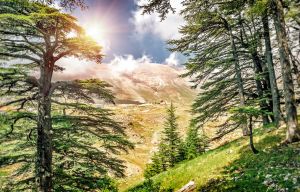Lebanese Cedars
It's no wonder that the cedar is the national emblem of Lebanon, displayed right in the center of the country's flag - prized by the Egyptians for building ships and the Ottomans for building railways, the Lebanese cedar's renown is so influential that it is mentioned throughout texts from the Epic of Gilgamesh to the Holy Bible. The cedars once flourished in thick forests stretching across Mount Lebanon, not least of which is the Forest of the Cedars of God near the town of Bsharri. Continual deforestation by the Phoenicians, Egyptians, Assyrians, Babylonians, Persians, Romans, Israelites, and Turks vastly reduced the scope of these forests, to the extent that Emperor Hadrian was moved to claim them as imperial domain in order to temporarily halt their destruction. In 1876, Queen Victoria paid for a high stone wall to protect the Lebanon cedar saplings from goats, an effort that was ultimately negated by British troops during World War I who harvested the cedar to build railroads. Cedars helped the Phoenicians become the first sea trading nation in the world, as the wood was used as ship timber; Egyptians used cedar resin in the mummification process and cedar wood in some of their first papyrus rolls. The Epic of Gilgamesh relates a legendary battle that occured between the demigods and humans over the cedar forests of southern Mesopotamia, and Gilgamesh was said to have used the cedar wood to build his city. The Bible references the Lebanon cedar in multiple passages, often in terms of metonymous praise: "The righteous flourish like the palm tree and grow like the cedar in Lebanon" (Psalm 29:5); "Behold, I will liken you to a cedar in Lebanon, with fair branches and forest shade" (Ezekiel 31:3); "The trees of the Lord are watered abundantly, the cedars of Lebanon that he planted" (Psalm 104:16 NRSV). Today, active programs to protect the cedars in Lebanon combine replanting and natural regeneration with protection from goats, hunting, forest fires, and woodworms. The remaining cedars are found in mountainous areas and state-run reserves including the Chouf Cedar Reserve, Jaj Cedar Reserve, Tannourine Reserve, Ammouaa and Karm Shbat Reserve, and the Forest of the Cedars of God. |
 |








